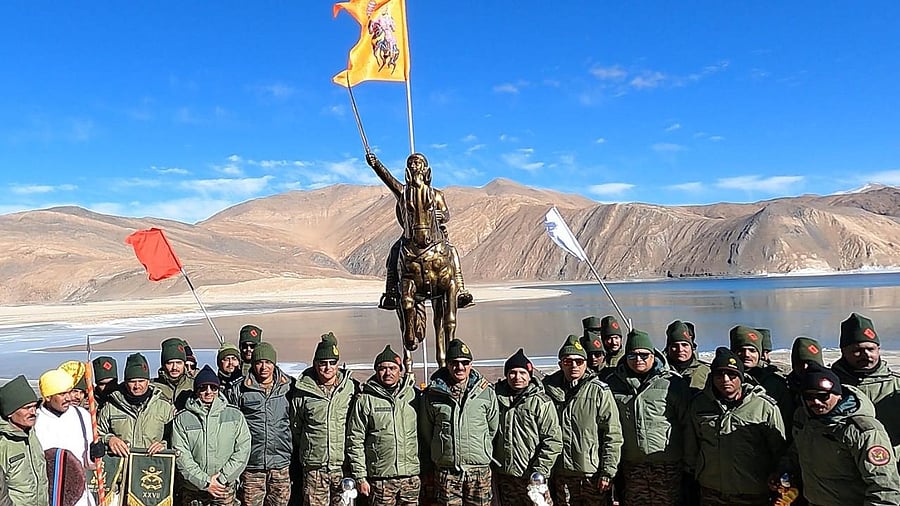
Chhatrapati Shivaji Maharaj statue at Pangong Tso, near the India-China border.
Credit: X/@firefurycorps
Srinagar: The Indian Army’s recent installation of a statue of Maratha warrior Chhatrapati Shivaji Maharaj at Pangong Tso, near the India-China border, has sparked debate over its relevance to Ladakh heritage and ecology and the lack of local input in its construction.
According to sources, the statue was placed within the Maratha Unit’s location, funded by voluntary contributions from serving and retired personnel of the Unit. However, this has not stopped criticism, with many questioning its appropriateness for the region.
Ladakh councillor Konchok Stanzin took to social media to voice his objections, calling the statue an inappropriate choice for the unique environment of Pangong Tso.
“As a local resident, I must voice my concerns about the Shivaji statue at Pangong. It was erected without local input, and I question its relevance to our unique environment and wildlife. Let's prioritize projects that truly reflect and nature," the Chushul councillor posted on X.
Sajjad Kargili, a political activist from neighboring Kargil district, echoed similar concerns, stating that Shivaji holds no historical or cultural significance to the region.
“While we respect his legacy, imposing such cultural symbols here is misplaced. We would appreciate the installation of statues honoring local historical figures like Khree Sultan Cho or Ali Sher Khan Anchen and Seenge Namgyal. However, even these should not be placed in environmentally sensitive areas like Pangong, which require careful preservation,” he posted on X.
The statue was inaugurated on Saturday by Lt Gen Hitesh Bhalla, General Officer Commanding of the Army’s Leh-based 14 Corps, also known as the Fire and Fury Corps. The Army described the statue as a tribute to the “unwavering spirit” of the Maratha ruler, whose legacy is seen as a source of inspiration for generations.
“The towering symbol of valour, vision and unwavering justice was inaugurated by the General Officer Commanding Fire and Fury Corps Lt Gen Hitesh Bhalla, who is also the Colonel of the Maratha Light Infantry,” it said on X.
Some military veterans, however, have suggested that a statue of Dogra General Zorawar Singh, who led the conquest of Ladakh in the 19th century, would have been more appropriate. Maj. Gen. Birender Dhanoa (Retd.) questioned the publicity around the statue, asking whether all units across the Corps would now be erecting statues of their respective ancestral leaders.
“A simple question for you guys in 14 Corps? Why was a unit and ‘colonel of the regiment’ affair publicised on Social Media? Are all fixed class units erecting statues across the Corps Z [zone] that are in keeping with their ancestral satraps? If not then social media isn’t the place for a one off,” he questioned.
General Singh’s military campaign between 1834 and 1840 is credited for the merger of the erstwhile Ladakh kingdom with the Dogra kingdom, which was then part of the Sikh empire ruled by Maharaja Ranjit Singh of Lahore.
The statue is part of the Army’s broader strategy to enhance its presence in Ladakh, a region of immense strategic significance due to its proximity to the India-China border. The lake gained prominence during the 2020 standoff when both Indian and Chinese forces clashed in the area.
Alongside infrastructure developments like roads and bridges, the statue reflects India’s efforts to solidify its position along the Line of Actual Control (LAC).